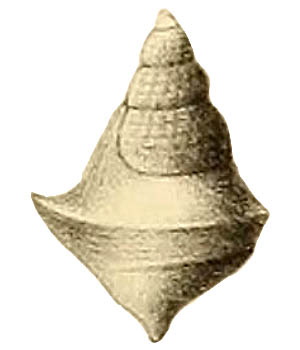Species / Goniocheila Castorensis
Stromboidea
Original Description of Aporrhais (Goniocheila) castorensis by Whitfield, 1877, p. 38:
- "Shell small, with a moderately elevated spire, composed of about four flattened or slightly ventricose volutions, which are crossed by fine flexuous, vertical folds, strongly directed forward in their course across the whorl, and also marked by fine thread-like revolving lines; suture distinct; apical angle about 40°, but slightly variable on different individuals. Body volution proportionally large and very strongly angular, or even carinate, along the middle, flattened or slightly cocave on the upper surface and rapidly contracted below to the short, pointed rostral beak. A second rather indistinct carination marks the surface a little below the first, but seldom or never extends to the margin of the lip. Outer lip expanded, strongly carinate on the back and projecting in the middle, to form a short, obtuse, slightly recuved digitation, and posteriorly extending along the spire to the base of the second volution above."
Locus typicus: East Fork of Beaver Creek, Black Hills, Dakota, USA
Stratum typicum: ferruginous sandy limestone, associated with fossils of the Fort Benton group, Turonian ?, upper Cretaceous
Aporrhais (Goniocheila) castorensis Whitfield, 1877, pl. XII, fig. 1
Comment from Saul & Petit, 2001 : The three species of Goniocheila are a distinctive and compact group, showing far less morphologic diversity than has been ascribed to "A." speciosa s.l. Roy (1994) showed Goniocheila as present in the Turonian, based upon Aporrhais (Goniocheila) castorensis Whitfield,1877, from the Benton Shale in the Black Hills, but the inadequately figured holotype (Whitfield, 1880: pi. 12, fig. 1; Stanton, 1893: pi. 31, fig. 1) lacks characteristics of Goniocheila, and appears closer to Drepanocheilus. Abbass (1967) referred an incomplete aporrhaid specimen from the Eocene of Egypt questionably to Goniocheila orientalis, but the fine arcuate ribbing of the spire is more suggestive of Drepanocheilus than of Goniocheila. At present, no specimens of earlier than Oligocene age can be assigned to Goniocheila, and the genus ranges from early to latest Oligocene or early Miocene age.
References
- H. Newton, W. P. Jenney, et al., Report on the Geology & Resources of the Black Hills of Dakota (Government Printing Office, Washington, D.C., 1880).
- R.P. Whitfield, 1877. Preliminary report on the Paleontology of the Black Hills, containing descriptions of new species of fossils from Potsdam, Jurassic, and Cretaceous formations of the Black Hills of Dakota. U.S. Geographical and Geological Survey of the Rocky Mountain region, J.W. Powell in charge. Washington, pp. 1-49.
- R.P. Whitfield, 1899. List of fossils, types and figured specimens, used in the palaeontological work of R.P. Whitfield, showing where they are probably to be found at the present time. Lancaster, New Era Print. (Fulltext) p.166,167

